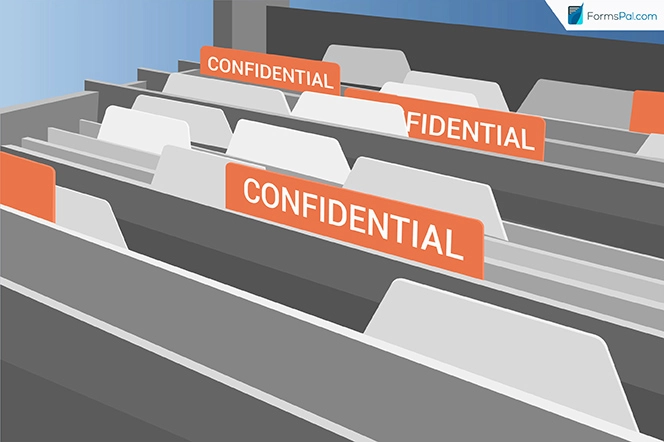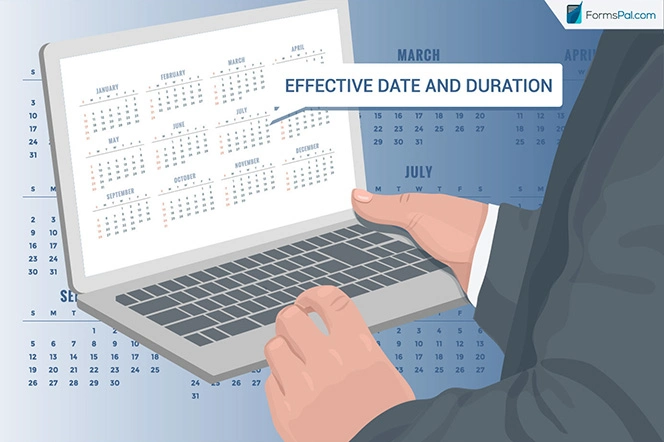What is a Non-disclosure Agreement?
A non-disclosure agreement (NDA) is a legal contract concluded between the owner of confidential information and its recipient. An NDA (also called a confidentiality form) is required when someone wants to protect sensitive data from being disclosed to the public or unauthorized third party. Such data may include inventions, products, services, financial information, or customer lists. A non-disclosure agreement helps do business without worrying that your competitors will know your secrets.
Here some useful definitions that might be helpful while working with a non-disclosure agreement:
“Confidential” or “Proprietary information” is any non-public information owned by a certain natural or legal person and disclosed at their will.
“Discloser” or “Disclosing Party” is the party who owns the confidential information and who’s sharing it with the recipient.
“Recipient” or “Receiving Party” is the party who’s being trusted with the confidential information.
“Trade secret” is a type of intellectual property referring to the business ownership of a pattern, program, device, technique, or process that provides a competitive edge.
“Know-how” is protected results of the party’s intellectual activity; practical knowledge, or skills.
“Non-circumvention” means that the recipient will not engage directly with the disclosed contacts without the prior written consent of the disclosing party.
When to Use a Non-Disclosure Agreement?
A non-disclosure agreement is becoming an integral part of almost all business activities and relationships in the information age. When getting a new business opportunity or hiring a new employee, every company wants to ensure that its confidentiality will be well-protected. An NDA is a good way to protect all sensitive data from being publicly disclosed. What’s more important, in case of unauthorized disclosure, an NDA allows the injured party (the discloser) to take legal actions against the offender (the recipient) for violating the agreement’s terms. The list of information allowed to be legally protected is almost unlimited and may include the following.
Ideas, inventions, or know-how
When developing a new product, NDAs help inventors protect their intellectual property rights. Public disclosure of the new invention is one of the main reasons why inventors lose their patent rights. However, a well-prepared NDA allows creators to protect their intellectual goods, including, but not limited to, products, services, development documents, technical solutions, or marketing research results.
Business and financial information
Production and financial processes in business are quite important to be publicly available, especially for competitors. Therefore, they should be legally protected, as well. In this case, a non-disclosure agreement may define as confidential the following materials: primary accounting documents and financial statements, financial condition, business strategies, or data on the most profitable ways of cash. NDA can also protect the marketing strategies and advertising techniques.
Staff and Customer Data
Legal protection also applies to the company’s staff and customer data that is not available to the public, including customer lists, contact information, staff composition, selection, and formation. The non-disclosure contract also includes all business internal and external communication, information on the concluded agreements, as well as descriptions of products and/or services purchased, leased, or received from an individual or business.
A quality confidentiality template should always precisely describe what information is not allowed to be disclosed to the public. Technically, all knowledge shared between parties of the agreement can be considered confidential: software development, passwords, or system’s specification. However, in some cases, information cannot be reasonably regarded as confidential. For example, information that is independently developed or discovered by the recipient or legally received from a third party or public sources.
How to Create a Non-Disclosure Agreement?
To create a quality document, you have to be very attentive and consider all the necessary information to be included. Try our CDA builder to customize the document to your needs. The following steps can lessen your workload while preparing a document.
Step 1. Identify the parties to the agreement

At the beginning of the document, the owner of proprietary information and its recipient(s) should be identified. It’s necessary to define whether it’s a one-sided or mutual NDA.
Step 2. Define the confidentiality

The most important clause is devoted to the definition of confidential information and its exclusions. As the owner, you ought to be very precise in defining sensitive data you are giving access to. The information regarding your invention, idea, trade secret, financing, or marketing materials should be well-outlined. Do not describe confidentiality too broadly because it can lead to further misunderstandings and disputes. Moreover, too broad scopes can be considered invalid in the court.
Step 3. Describe the obligations

Either party should know the obligation not to disclose any confidential information or trade secret, indicated in the NDA, without the disclosing party’s prior consent. In this clause, you should also clearly outline the ownership and return obligation, which means that the receiving party ought to return or/and destroy any copy of confidential data after the termination of this agreement.
Step 4. Set the time frame of confidentiality

Every NDA should have an effective date and duration of the agreement. Typically, NDAs are signed for 1—5 years. Of course, the owner of confidential information wants to enforce the NDA for as long as possible. However, the terms of the agreement should be realistic and depend on the nature of the transaction. Possible termination of this agreement can also be indicated in this clause. Note that trade secrets have no expiration date.
Step 5. Describe the remedies

The remedies are important things to add to the agreement. They help bring the offending party to justice and may include monetary damage or/and injunctive relief. Any party violating the agreement would be legally liable to compensate for damages.
Step 6. Add additional terms

This clause may cover non-circumvention requirements (which protect the owner from being bypassed in business transactions), the governing laws that apply to the agreement, and how potential disputes can be settled.
Step 7. Sign the document

When all the necessary information is defined, and a non-disclosure agreement is prepared, all the parties involved should sign the document. It is recommended to sign the NDA with a notary acknowledgment to verify the identity of each party.
Frequently Asked Questions about the Confidentiality Agreement
What benefits do I get by signing a CA?
A signed confidentiality agreement (CA) is invaluable when dealing with confidential information and trade secrets. It establishes a confidential relationship between the parties and provides mutual trust. Without a non-disclosure agreement, your business partners or employees may disclose your sensitive information or use it otherwise. A quality CA clearly defines what is considered confidential and what information is allowed to be disclosed. It helps to avoid any ambiguity in the future.
As a legal document, the non-disclosure agreement authorizes you, as the discloser, to file a lawsuit against the recipients should they violate the confidentiality obligation. Overall, NDAs maintain the secrecy of the information shared between two or more parties and reduces the chances of important data going out of the company or organization.
What if a Non-Disclosure Agreement is being violated?
Breaking an NDA is the same as breaking any other contract. In the event of NDA’s breach, the disclosing party is entitled to take legal actions against the offending party and get either monetary damage or an injunction. That’s why the agreement should contain the remedies clause, which determines the costs of violating the document.
At any point, after discovering public disclosure of your confidential data, it is crucial to gather evidence against the violation of the NDA’s terms as soon as possible. The injured (disclosing) party should find out who and how has leaked the information. Before filing a lawsuit, the disclosing party is required to consider whether the leaked information is being disclosed intentionally or accidentally and whether the recipient is the one who is responsible for the leak. It is also important to prove that such a leak has actually caused damage to the company.
Is it possible to terminate a confidentiality agreement before the end date?
The “termination” clause usually does not exist in the non-disclosure agreement, as it destroys the document’s whole concept. However, it’s possible to terminate the agreement before the end date by the parties’ mutual agreement. It’s usually indicated in the contract and describes how such a decision can be notified to the other party(-ies). In most cases, a prior written notice within a specific period of time is required.
Note that confidentiality obligations can be continued even after the termination of the agreement. In this case, the receiving party will also be obliged to return or/and destroy any copy of disclosed information after the NDA’s termination.
Is there a difference between Non-Disclosure and Non-Compete Agreements?
Yes, these are not the same. A non-compete agreement is always a one-way agreement, which prevents the receiving party from competing against the disclosing party. Thus, the receiving party may be obliged not to work in the same business field companies for a certain period of time or within a specific geographic area. A non-disclosure agreement, in its turn, is designed to protect confidential information or trade secrets from unauthorized disclosure. NDAs can be both one-sided and mutual.
Note that, sometimes, non-compete and non-disclosure clauses can be united within one contract. However, we advise you where it’s possible to use these two documents separately.
